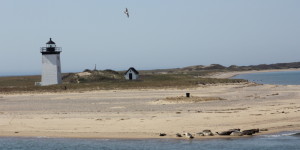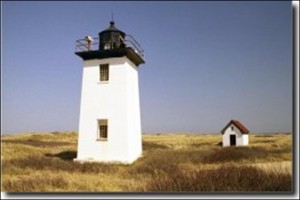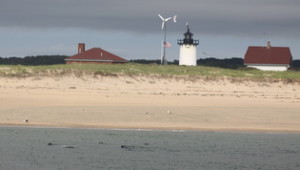Naturalist’s Notebook: September 13 – September 19
The most commonly reported things from this week’s whalewatches are the landmarks. The naturalist on nearly every trip makes note of one lighthouse or another. Repeated mentions are made of Race Point Light, Wood End Light, and Long Point Light.
Long Point Light is the first a whalewatch boat passes leaving from Provincetown. It sits near the end of Long Point Beach, protruding out into the mouth of Provincetown Harbor. The first light here was built in 1826 at a cost of sixteen thousand dollars. It was a wooden tower and lantern room built off the roof of the keeper’s house. It’s fixed white light was visible for thirteen nautical miles. Sixth order Fresnel lenses replaced the original Lewis lanterns in 1856. In 1861, two cannon batteries were erected near the site to protect the harbor from the threat of blockade by the confederate navy. These would later become known as Fort Useless and Fort Ridiculous.

The current square, brick light was built in 1875 for thirteen thousand dollars. The light remained a fixed white light with fifth order Fresnel lenses. A twelve-hundred pound fog bell was also erected on the sight at that time. In 1904, an oil house was built on the site. Optics were upgraded in 1952 and again in 1982, when the signal was automated and the solar panels were installed. Today, the light shines as a fixed green marker.
Wood End Light sits on Long Point Beach, just where it bends away to the north. Legend has it that it was so named because when the Pilgrims first arrived here in 1620, the old growth, hardwood forests extended the entire length of the outer cape to the point where the square, brick light was build in 1872 at a cost of fifteen thousand dollars (including the keepers house). Its flashing red signal could be seen from eleven miles away. In 1896, the light was converted to kerosene. An oil house and a keeper’s house were built that year. The rotating lenses were installed in 1900 and a fog bell was added in 1902. In 1961, Wood End Light was automated and the keeper’s house demolished. In 1981, the solar panel conversion took place.

There has been a lighthouse on Race Point since 1816. The first was a rubblestone tower equipped with a revolving light. That effect distinguished Race Point Light from the nearby Highland Light. In 1852, a fog bell was added and, in 1855, a fourth order Fresnel Lens was installed. In 1873, a brick building was built to house the steam-driven fog whistle. In 1874, a second keeper’s house was added to the complex. The following year, the tower was covered with wooden shingles. In 1876, the cone-shaped cast iron light that you see today was built and lined with bricks. In 1957, it became an electrofied light but it wasn’t until 1978 that it became automated. The second keeper’s house was abandoned and allowed to fall into disrepair (the first being demolished in 1960). In 1995, it would come under the care of the American Lighthouse Foundation and was remodelled. It continues to serve as a guest house.

That these three landmarks have been mentioned so frequently in this week’s reports indicates that a fair number of whales, especially finbacks and minkes have been spending a great deal of time near the shoreline. That’s not very suprising when you consider that the reasons those lighthouses were needed are the same reasons why the areas are productive places for whales to find food. The lighthouses are necessary because sandbars and shallows are a threat to navigation. Those same sandbars and shallows cause upwellings that bring the colder, nutrient-rich waters up from the bottom. So these areas are in some ways very similar to the southwest corner of Stellwagen Bank. And that Southwest Corner is where most of the feeding behavior of humpback whales was reported this week.





